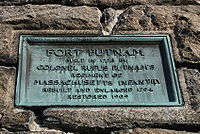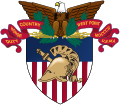| Fort Putnam | |
|---|---|
| Part of United States Military Academy | |
| West Point, New York | |
 The east wall and guns of Fort Putnam that face the
Hudson River | |
 | |
| Site information | |
| Owner | United States Army |
| Controlled by | US Army |
| Open to the public | Late spring until mid-fall. Check with USMA Museum for access hours and dates |
| Condition | restored |
| Site history | |
| Built | 1778 |
| Built by | Colonel Rufus Putnam |
| Battles/wars | Revolutionary War |
| Garrison information | |
| Garrison | West Point |
Fort Putnam was a military garrison during the Revolutionary War at West Point, New York, United States. Built by a regiment of Colonel Rufus Putnam's 5th Massachusetts Regiment, it was completed in 1778 with the purpose of supporting Fort Clinton, [1] which sat on the edge of the Hudson River about 3/4 of a mile away. [2] [3] The fort was rebuilt and enlarged in 1794 before falling into disuse and disrepair as the military garrison at West Point became obsolete in the early mid-19th century. It underwent a major preservation as a historical site in 1909, and has been continually in the process of preservation since. Sitting at an elevation of 500 feet, it was West Point's largest garrison during the Revolutionary War. The Fort is under the supervision of the West Point Museum Director, David M. Reel, and is operated by the United States Army Garrison, West Point. Access to the Fort is seasonal and as summer staff are available. [4] [5]
Construction
In 1778, Gen. Alexander McDougall wrote, "Genl. Parson, Clinton and Col. Delaradiere went with me to View the Rock & Crown Hills in the rear of our works..."( Fort Clinton). Tadeusz Kościuszko convinced them of the necessity of defending Crown Hill, and drafted blueprints accordingly. Gen. Israel Putnam's younger cousin, Col. Rufus Putnam, and three hundred men arrived on four sloops with lumber to build Fort Putnam. McDougall wrote, "The hill which Col. Putnam is fortifying is the most commanding and important of any that we can now attend to...the easternmost face of this work must be so constructed as to command the plain." [6] [7]: 57
-
Information plate near the entrance
See also
References
- ^ "Fort Putnam". University of North Carolina. Retrieved 1 May 2010.
- ^ Hubbard, Robert Ernest. General Rufus Putnam: George Washington's Chief Military Engineer and the "Father of Ohio," pp. 64–72, McFarland & Company, Inc., Jefferson, North Carolina, 2020. ISBN 978-1-4766-7862-7.
- ^ "Fort Putnam". United States Military Academy. Archived from the original on 4 January 2010. Retrieved 1 May 2010.
- ^ "Fort Putnam". New York State Military Museum. Retrieved 1 May 2010.
- ^ Hubbard, Robert Ernest. General Rufus Putnam: George Washington's Chief Military Engineer and the "Father of Ohio," pp. 71–2, McFarland & Company, Inc., Jefferson, North Carolina, 2020. ISBN 978-1-4766-7862-7.
- ^ Storozynski, A., 2009, The Peasant Prince, New York: St. Martin's Press, ISBN 9780312388027
- ^ Hubbard, Robert Ernest. General Rufus Putnam: George Washington's Chief Military Engineer and the "Father of Ohio," pp. 64–5, McFarland & Company, Inc., Jefferson, North Carolina, 2020. ISBN 978-1-4766-7862-7.


